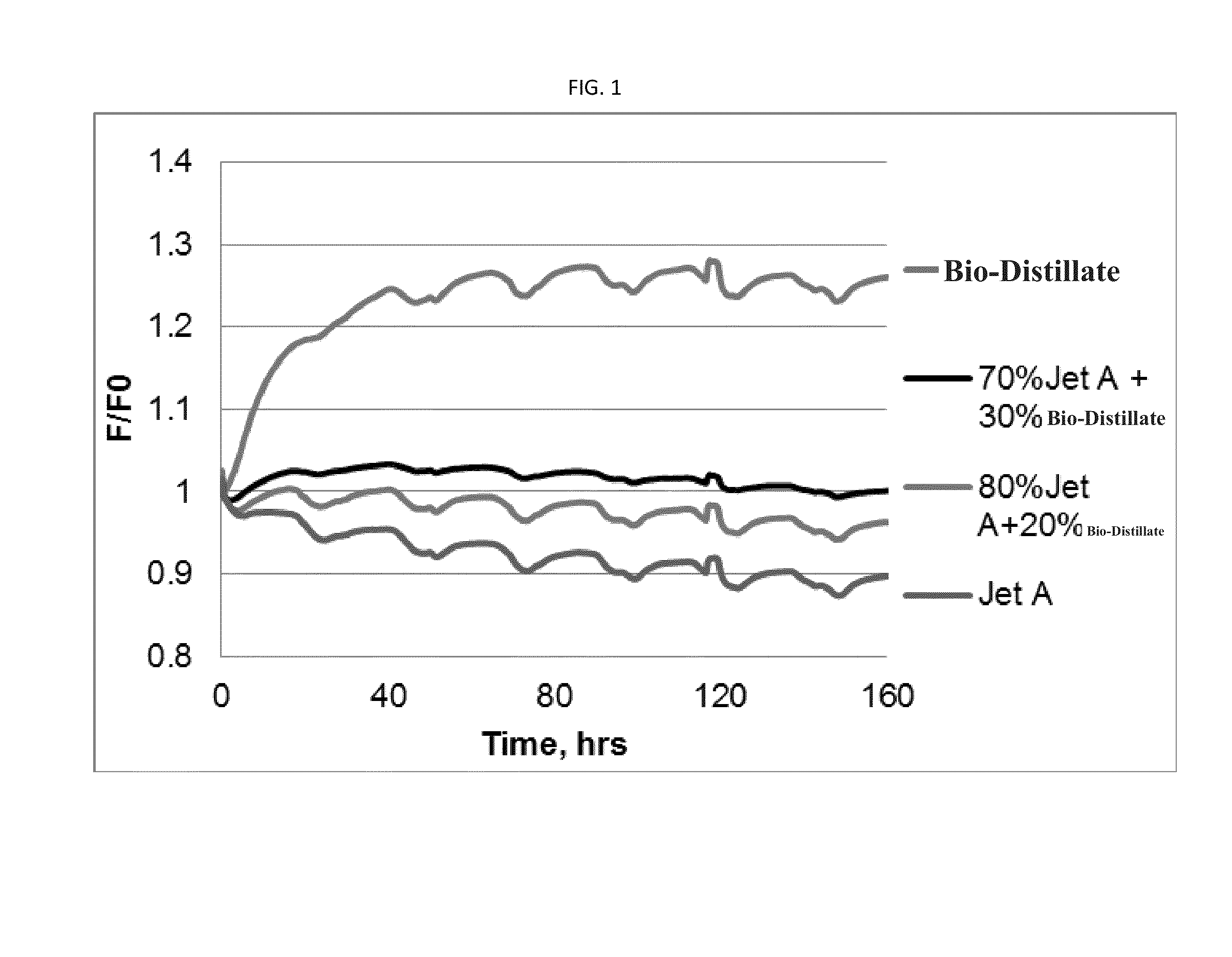Renewable fuel composition and method of using the same
a fuel composition and renewable technology, applied in the field of distillate fuel, can solve the problems of low aromatic distillate lacking important fuel properties, fuel lines, and affecting the operation of fuel filters, etc., and achieves the effects of low temperature property value, low temperature property, and low temperature property
- Summary
- Abstract
- Description
- Claims
- Application Information
AI Technical Summary
Benefits of technology
Problems solved by technology
Method used
Image
Examples
example 1
[0100]In two separate runs, southern yellow pine wood chips were converted by thermo-catalytic conversion. The liquid products were separated from the gaseous products by condensation. Each of the resulting liquid products was further separated by gravity separation to form a bio-oil phase and an aqueous phase. The bio-oil phases were separately subjected to hydrotreatment wherein at least a portion of the oxygenated compounds were deoxygenated to form a first and a second hydrotreated bio-oil. A first bio-distillate fraction having a boiling point range of from around 330 to around 700° F. was separated from the first hydrotreated bio-oil. A second bio-distillate fraction having a boiling point range of from around 330 to around 550° F. (Jet fuel range) was also separated from the first hydrotreated bio-oil. A third bio-distillate fraction having a boiling point range of from around 330 to around 550° F. (Jet fuel range) was separated from the second hydrotreated bio-oil.
[0101]Samp...
example 2
[0107]This Example tested the volume swell of O-rings by optical dilatometry at room temperature. The O-rings were composed of nitrile rubber (N0602), fluorosilicone (L1120), and fluorocarbon (V0747) and were manufactured by Parker Hannifin. The plasticizer was removed from examples of the N0602 nitrile rubber using acetone extraction and designated N0602e. For each analysis two size −001 O-rings were cut in half with one section from each O-ring being used for the analysis.
[0108]The volume swell of the O-rings was measured placing the samples in a reservoir along with 10 mL of the test fuel. Starting at 2 minutes after being immersed in the fuel the samples were digitally photographed every 20 seconds for the next 3 minutes. At 6 minutes total elapsed time the samples were photographed every 60 minutes for the next 40 hours. After the aging period was completed the cross-sectional area was extracted from the digital images and taken as a characteristic dimension proportional to the...
example 3
[0112]Elastomer testing was performed on nitrile rubber (N0602), fluorosilicone (L112) and fluorocarbon (VO747) in a similar manner to that set forth in Example 1. The volume change showed little effect of the POSF 8123 blend was noted for fluorocarbon and fluorosilicone O-rings while volume swell was noted with nitrile O-rings. Volume swell was noted to increase significantly with the aromatic level of the fuel, with 15 and 20% aromatic fuel having about 70% the volume swell observed with the POSF 8123 blend. It can be concluded that nitrile O-rings tend to be most susceptible to shrinkage.
PUM
| Property | Measurement | Unit |
|---|---|---|
| boiling point | aaaaa | aaaaa |
| boiling point | aaaaa | aaaaa |
| boiling point | aaaaa | aaaaa |
Abstract
Description
Claims
Application Information
 Login to View More
Login to View More - R&D
- Intellectual Property
- Life Sciences
- Materials
- Tech Scout
- Unparalleled Data Quality
- Higher Quality Content
- 60% Fewer Hallucinations
Browse by: Latest US Patents, China's latest patents, Technical Efficacy Thesaurus, Application Domain, Technology Topic, Popular Technical Reports.
© 2025 PatSnap. All rights reserved.Legal|Privacy policy|Modern Slavery Act Transparency Statement|Sitemap|About US| Contact US: help@patsnap.com

